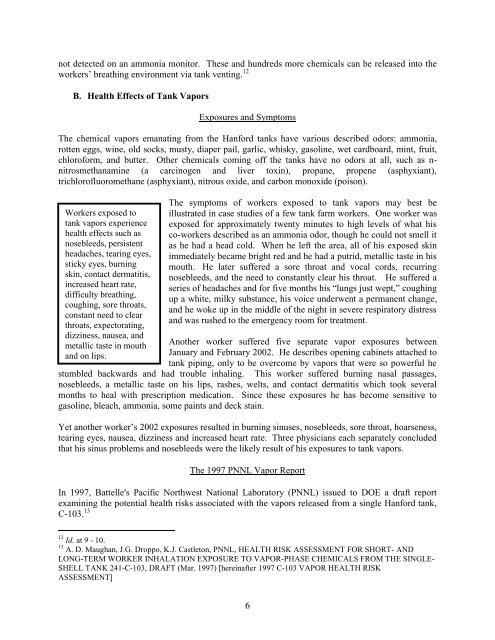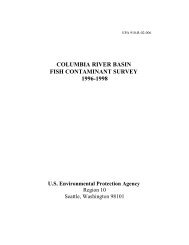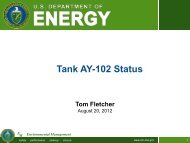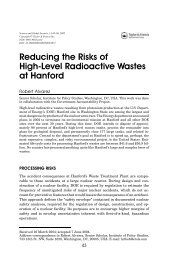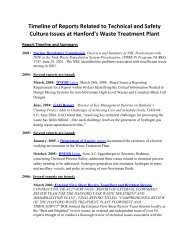Knowing Endangerment - Hanford Challenge
Knowing Endangerment - Hanford Challenge
Knowing Endangerment - Hanford Challenge
You also want an ePaper? Increase the reach of your titles
YUMPU automatically turns print PDFs into web optimized ePapers that Google loves.
not detected on an ammonia monitor. These and hundreds more chemicals can be released into the<br />
workers‟ breathing environment via tank venting. 12<br />
B. Health Effects of Tank Vapors<br />
Workers exposed to<br />
tank vapors experience<br />
health effects such as<br />
nosebleeds, persistent<br />
headaches, tearing eyes,<br />
sticky eyes, burning<br />
skin, contact dermatitis,<br />
increased heart rate,<br />
difficulty breathing,<br />
coughing, sore throats,<br />
constant need to clear<br />
throats, expectorating,<br />
dizziness, nausea, and<br />
metallic taste in mouth<br />
and on lips.<br />
Exposures and Symptoms<br />
The chemical vapors emanating from the <strong>Hanford</strong> tanks have various described odors: ammonia,<br />
rotten eggs, wine, old socks, musty, diaper pail, garlic, whisky, gasoline, wet cardboard, mint, fruit,<br />
chloroform, and butter. Other chemicals coming off the tanks have no odors at all, such as n-<br />
nitrosmethanamine (a carcinogen and liver toxin), propane, propene (asphyxiant),<br />
trichlorofluoromethane (asphyxiant), nitrous oxide, and carbon monoxide (poison).<br />
The symptoms of workers exposed to tank vapors may best be<br />
illustrated in case studies of a few tank farm workers. One worker was<br />
exposed for approximately twenty minutes to high levels of what his<br />
co-workers described as an ammonia odor, though he could not smell it<br />
as he had a head cold. When he left the area, all of his exposed skin<br />
immediately became bright red and he had a putrid, metallic taste in his<br />
mouth. He later suffered a sore throat and vocal cords, recurring<br />
nosebleeds, and the need to constantly clear his throat. He suffered a<br />
series of headaches and for five months his “lungs just wept,” coughing<br />
up a white, milky substance, his voice underwent a permanent change,<br />
and he woke up in the middle of the night in severe respiratory distress<br />
and was rushed to the emergency room for treatment.<br />
Another worker suffered five separate vapor exposures between<br />
January and February 2002. He describes opening cabinets attached to<br />
tank piping, only to be overcome by vapors that were so powerful he<br />
stumbled backwards and had trouble inhaling. This worker suffered burning nasal passages,<br />
nosebleeds, a metallic taste on his lips, rashes, welts, and contact dermatitis which took several<br />
months to heal with prescription medication. Since these exposures he has become sensitive to<br />
gasoline, bleach, ammonia, some paints and deck stain.<br />
Yet another worker‟s 2002 exposures resulted in burning sinuses, nosebleeds, sore throat, hoarseness,<br />
tearing eyes, nausea, dizziness and increased heart rate. Three physicians each separately concluded<br />
that his sinus problems and nosebleeds were the likely result of his exposures to tank vapors.<br />
The 1997 PNNL Vapor Report<br />
In 1997, Battelle's Pacific Northwest National Laboratory (PNNL) issued to DOE a draft report<br />
examining the potential health risks associated with the vapors released from a single <strong>Hanford</strong> tank,<br />
C-103. 13<br />
12 Id. at 9 - 10.<br />
13 A. D. Maughan, J.G. Droppo, K.J. Castleton, PNNL, HEALTH RISK ASSESSMENT FOR SHORT- AND<br />
LONG-TERM WORKER INHALATION EXPOSURE TO VAPOR-PHASE CHEMICALS FROM THE SINGLE-<br />
SHELL TANK 241-C-103, DRAFT (Mar. 1997) [hereinafter 1997 C-103 VAPOR HEALTH RISK<br />
ASSESSMENT]<br />
6


